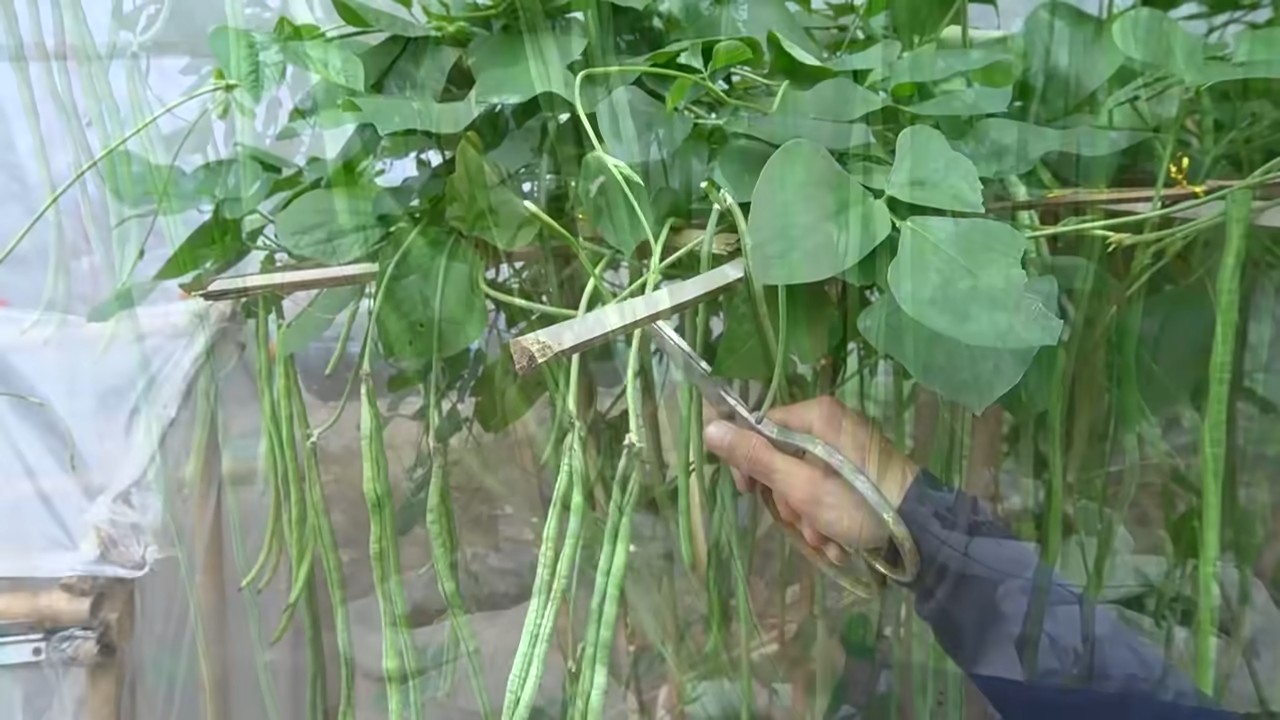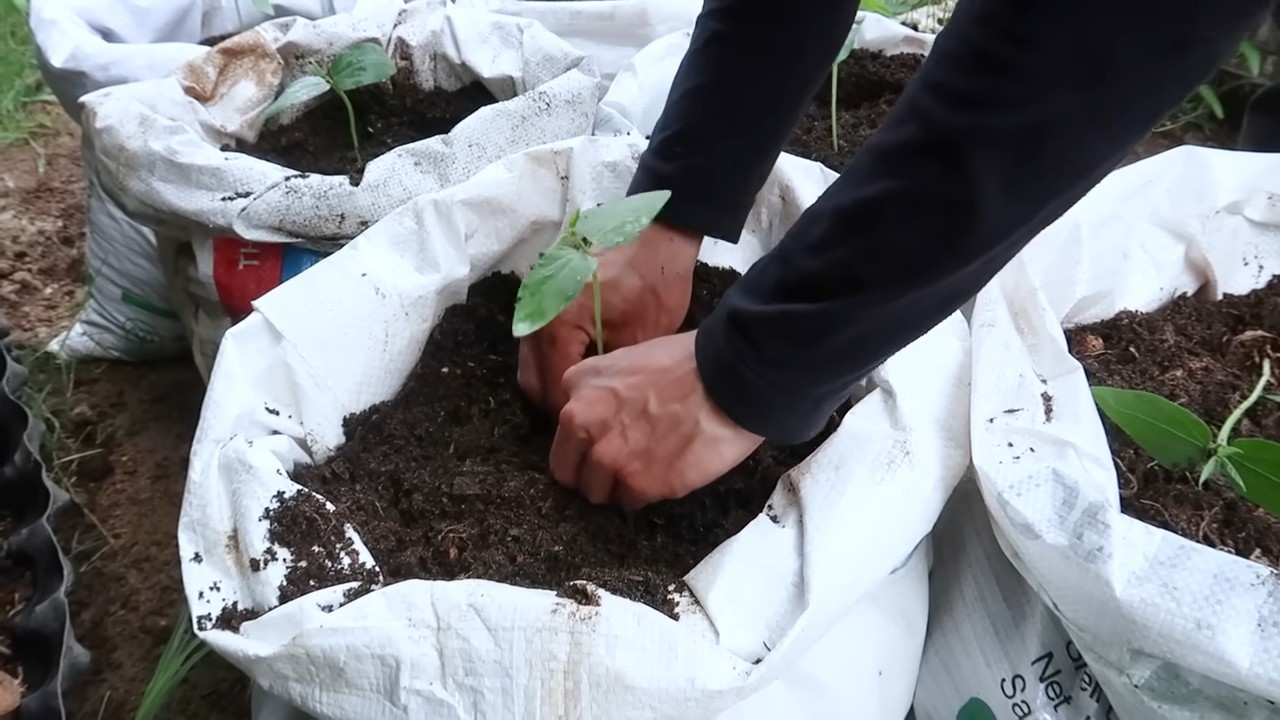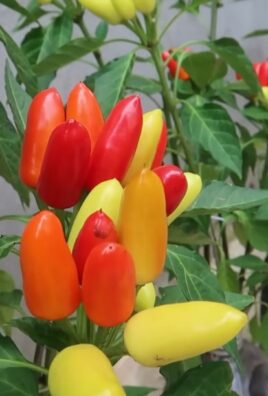Long bean gardening tips are what you need to unlock a bountiful harvest right in your backyard! Have you ever dreamt of snipping fresh, vibrant long beans straight from your garden, knowing exactly where they came from and how they were grown? It’s more achievable than you think, and I’m here to guide you through it. For centuries, cultivating beans has been a cornerstone of sustainable agriculture, providing essential nutrients and connecting us to the earth. In many cultures, beans symbolize prosperity and good fortune, and growing your own long beans can bring that same sense of abundance to your life.
But let’s be honest, sometimes gardening feels more like a battle than a blissful experience. Pests, diseases, and unpredictable weather can quickly turn your green dreams into a brown nightmare. That’s where these DIY tricks and hacks come in! I’ve compiled a collection of simple, effective, and budget-friendly solutions to common long bean gardening challenges. From creating the perfect soil mix to warding off pesky insects naturally, these tips will empower you to grow healthy, delicious long beans with confidence. So, ditch the store-bought beans and embrace the joy of homegrown goodness. Let’s dive into these long bean gardening tips and transform your garden into a thriving oasis!

Grow Your Own Delicious Long Beans: A Beginner’s Guide
Hey there, fellow gardening enthusiasts! I’m so excited to share my secrets to growing long beans, also known as yardlong beans or asparagus beans. These vigorous climbers are not only incredibly productive but also add a touch of exotic flair to your garden. Trust me, there’s nothing quite like harvesting your own fresh, crisp long beans for a stir-fry or salad. Let’s dive in!
Choosing the Right Variety and Location
Before we get our hands dirty, let’s talk about selecting the perfect long bean variety and finding the ideal spot in your garden.
* Variety Selection: There are several long bean varieties available, each with slightly different characteristics. Some popular choices include ‘Red Noodle,’ ‘Chinese Red Noodle,’ ‘Orient Wonder,’ and ‘Yardlong.’ I personally love ‘Red Noodle’ for its vibrant color and excellent flavor. Consider your local climate and growing season when making your selection.
* Sunlight: Long beans are sun-worshippers! They need at least 6-8 hours of direct sunlight each day to thrive. Choose a location in your garden that receives plenty of sunshine.
* Soil: Well-drained soil is crucial for long bean success. They don’t like soggy feet! Amend your soil with compost or other organic matter to improve drainage and fertility. A slightly acidic to neutral pH (around 6.0-7.0) is ideal.
* Support System: Long beans are climbers, so they need a sturdy support system to grow on. This could be a trellis, fence, arbor, or even a teepee made of bamboo poles. Make sure your support is at least 6-8 feet tall to accommodate their vigorous growth.
Step-by-Step Planting Guide
Now for the fun part – planting! I’ll walk you through the process step-by-step.
1. Prepare the Soil: Start by loosening the soil in your chosen planting area. Remove any weeds, rocks, or debris. Incorporate compost or other organic matter to improve soil fertility and drainage. I usually add a generous amount of well-rotted manure as well.
2. Sow the Seeds: You can either direct sow the seeds in the garden or start them indoors. I prefer direct sowing because long beans don’t always transplant well.
* Direct Sowing: Wait until the soil has warmed up to at least 65°F (18°C) before direct sowing. This is usually a few weeks after the last frost. Sow the seeds about 1 inch deep and 2-3 inches apart. Space rows about 2-3 feet apart.
* Starting Indoors (Optional): If you live in a cooler climate with a shorter growing season, you can start the seeds indoors about 3-4 weeks before the last frost. Use biodegradable pots to minimize root disturbance when transplanting. Sow the seeds about 1 inch deep in a seed-starting mix. Keep the soil moist and provide plenty of light.
3. Watering: Water the seeds gently after planting. Keep the soil consistently moist but not waterlogged. Once the seedlings emerge, water deeply but less frequently.
4. Provide Support: As soon as the seedlings start to develop tendrils, provide them with a support system to climb on. Gently guide the tendrils towards the trellis or fence.
Caring for Your Long Bean Plants
Once your long bean plants are established, it’s important to provide them with the care they need to thrive.
* Watering: Water deeply and regularly, especially during hot, dry weather. Long beans need consistent moisture to produce abundant pods. I like to water early in the morning to allow the foliage to dry before nightfall, which helps prevent fungal diseases.
* Fertilizing: Long beans are heavy feeders. Fertilize them every 2-3 weeks with a balanced fertilizer or compost tea. Avoid using fertilizers that are too high in nitrogen, as this can promote excessive foliage growth at the expense of pod production.
* Weeding: Keep the area around your long bean plants free of weeds. Weeds compete with the plants for water, nutrients, and sunlight. Mulching can help suppress weed growth and retain soil moisture.
* Pest and Disease Control: Long beans are generally pest-resistant, but they can be susceptible to aphids, bean beetles, and fungal diseases. Inspect your plants regularly for signs of pests or diseases.
* Aphids: These tiny insects suck the sap from plants, causing them to weaken and become distorted. You can control aphids by spraying them with a strong stream of water or by using insecticidal soap.
* Bean Beetles: These beetles can defoliate long bean plants. Handpick them off the plants or use an insecticide specifically designed for bean beetles.
* Fungal Diseases: Fungal diseases such as powdery mildew and anthracnose can affect long bean plants, especially in humid conditions. Prevent fungal diseases by providing good air circulation, avoiding overhead watering, and applying a fungicide if necessary.
* Pruning: While not strictly necessary, pruning can help improve air circulation and promote bushier growth. You can prune off any yellowing or damaged leaves.
Harvesting Your Bounty
The moment we’ve all been waiting for – harvesting!
* When to Harvest: Long beans are typically ready to harvest about 60-70 days after planting. Harvest them when they are young, tender, and about 12-18 inches long. They should be firm and snap easily when bent.
* How to Harvest: Use scissors or pruning shears to cut the beans from the vine. Be careful not to damage the plant. Harvest regularly to encourage continued production.
* Storage: Freshly harvested long beans can be stored in the refrigerator for up to a week. Wrap them in a damp paper towel and place them in a plastic bag.
Troubleshooting Common Problems
Even with the best care, you might encounter some challenges along the way. Here are some common problems and how to address them:
* Poor Germination: If your long bean seeds aren’t germinating, it could be due to several factors:
* Cold Soil: Long beans need warm soil to germinate. Wait until the soil has warmed up to at least 65°F (18°C) before planting.
* Poor Quality Seeds: Use fresh, high-quality seeds.
* Overwatering: Overwatering can cause the seeds to rot. Keep the soil consistently moist but not waterlogged.
* Yellowing Leaves: Yellowing leaves can be a sign of nutrient deficiency, overwatering, or disease.
* Nutrient Deficiency: Fertilize your plants with a balanced fertilizer or compost tea.
* Overwatering: Allow the soil to dry out slightly between waterings.
* Disease: Inspect your plants for signs of disease and treat accordingly.
* Lack of Pod Production: If your long bean plants are growing well but not producing pods, it could be due to:
* Insufficient Sunlight: Make sure your plants are getting at least 6-8 hours of direct sunlight each day.
* Excessive Nitrogen: Avoid using fertilizers that are too high in nitrogen.
* Pollination Problems: Long beans are self-pollinating, but sometimes they need a little help. You can hand-pollinate the flowers by gently shaking the plants or using a small brush to transfer pollen from one flower to another.
Enjoying Your Harvest
Now that you’ve harvested your delicious long beans, it’s time to enjoy them! They are incredibly versatile and can be used in a variety of dishes.
* Stir-fries: Long beans are a classic ingredient in stir-fries. They add a crisp, slightly sweet flavor and a satisfying crunch.
* Salads: Add sliced long beans to your favorite salads for a boost of nutrients and flavor.
* Steamed or Blanched: Simply steam or blanch long beans and serve them as a side dish.
* Pickled: Pickled long beans are a delicious and tangy treat.
I hope this guide has inspired you to grow your own long beans. With a little care and attention, you can enjoy a bountiful harvest of these delicious and versatile vegetables. Happy gardening!

Conclusion
So, there you have it! Mastering the art of growing long beans doesn’t require a green thumb blessed by the gardening gods. It simply requires a little knowledge, a dash of patience, and the willingness to try these simple yet effective DIY tricks. We’ve explored how to optimize your soil, create the perfect support system, and even concoct natural pest repellents, all designed to maximize your long bean harvest.
Why is this a must-try? Because store-bought long beans simply can’t compare to the vibrant flavor and satisfying crunch of homegrown produce. Plus, knowing you nurtured these beans from seed to table adds a layer of accomplishment and connection to your food that’s truly rewarding. Imagine the delicious stir-fries, curries, and salads you can create with your abundant harvest!
But the benefits extend beyond just taste. Growing your own long beans is an environmentally friendly choice, reducing your reliance on commercially grown produce that often involves pesticides and long-distance transportation. It’s also a fantastic way to connect with nature, relieve stress, and get some much-needed fresh air and sunshine.
Don’t be afraid to experiment! Consider these variations to personalize your long bean gardening experience:
* Vertical Gardening with a Twist: Instead of traditional trellises, try using repurposed materials like old ladders or even sturdy branches to create unique and visually appealing support structures for your long beans.
* Companion Planting Power: Explore the benefits of companion planting by intercropping your long beans with other vegetables like carrots, cucumbers, or marigolds. These companions can help deter pests, improve soil health, and even enhance the flavor of your long beans.
* Seed Saving for Future Harvests: Once your long beans mature, consider saving some of the seeds for future planting. This is a great way to ensure a continuous supply of your favorite variety and adapt your long beans to your specific growing conditions.
* Different Varieties: There are many varieties of long beans, each with its own unique characteristics. Try growing different varieties to see which ones thrive best in your garden and which ones you prefer in terms of taste and texture. Some popular varieties include ‘Yardlong’, ‘Chinese Red Noodle’, and ‘Thai Purple Podded’.
We understand that gardening can sometimes feel daunting, but we’re confident that these DIY tricks will empower you to successfully cultivate a thriving long bean patch. Remember, even experienced gardeners face challenges, so don’t be discouraged if you encounter a few bumps along the way. The key is to learn from your mistakes, adapt your approach, and keep experimenting.
So, what are you waiting for? Grab your gardening gloves, gather your supplies, and embark on your long bean growing adventure today! We’re eager to hear about your experiences. Share your successes, challenges, and any other DIY tricks you discover along the way in the comments below. Let’s create a community of long bean enthusiasts and learn from each other! Happy gardening! Remember, successful long bean gardening is within your reach with these simple tips.
Frequently Asked Questions (FAQ)
What is the best time to plant long beans?
The ideal time to plant long beans is after the last frost in spring, when the soil has warmed up to at least 60°F (15°C). Long beans are warm-season crops and are sensitive to cold temperatures. Planting too early can stunt their growth or even kill them. In warmer climates, you can plant a second crop in late summer for a fall harvest. Check your local weather forecast and planting guides for specific recommendations based on your region.
How much sunlight do long beans need?
Long beans require at least 6-8 hours of direct sunlight per day to thrive. Choose a planting location that receives ample sunlight throughout the day. If you live in a particularly hot climate, some afternoon shade can be beneficial to prevent the plants from overheating. Insufficient sunlight can result in weak growth, reduced flowering, and a smaller harvest.
What type of soil is best for growing long beans?
Long beans prefer well-drained, fertile soil that is rich in organic matter. The ideal soil pH is between 6.0 and 7.0. Before planting, amend your soil with compost, aged manure, or other organic materials to improve its fertility and drainage. Avoid heavy clay soils, as they can become waterlogged and inhibit root growth. If you have clay soil, consider planting your long beans in raised beds or containers.
How often should I water my long beans?
Long beans need consistent moisture, especially during hot and dry periods. Water deeply and regularly, aiming to keep the soil consistently moist but not waterlogged. Avoid overhead watering, as this can promote fungal diseases. Instead, water at the base of the plants using a soaker hose or drip irrigation system. Mulching around the plants can also help retain moisture and suppress weeds.
What are some common pests and diseases that affect long beans?
Common pests that can affect long beans include aphids, bean beetles, spider mites, and whiteflies. Common diseases include powdery mildew, bean rust, and anthracnose. Regularly inspect your plants for signs of pests or diseases. Use organic pest control methods, such as insecticidal soap, neem oil, or diatomaceous earth, to control pests. To prevent diseases, ensure good air circulation, avoid overhead watering, and remove any infected leaves or plants promptly.
How do I know when my long beans are ready to harvest?
Long beans are typically ready to harvest about 60-70 days after planting. Harvest them when they are young, tender, and about 12-18 inches long. The pods should be firm and snap easily when bent. Avoid letting the pods become too mature, as they can become tough and stringy. Harvest regularly to encourage continued production.
Can I grow long beans in containers?
Yes, long beans can be successfully grown in containers, provided you choose a large enough container (at least 12 inches in diameter and depth) and provide adequate support for the vines. Use a well-draining potting mix and ensure the container receives plenty of sunlight. Water regularly and fertilize every few weeks with a balanced fertilizer.
How do I provide support for my long beans?
Long beans are climbing plants and require support to grow properly. You can use a trellis, fence, bamboo stakes, or even a sturdy branch to provide support. The support should be at least 6-8 feet tall to accommodate the long vines. Train the vines to climb the support by gently guiding them and tying them loosely with twine or plant ties.
What are the benefits of companion planting with long beans?
Companion planting can offer several benefits for long beans, including pest control, improved soil health, and enhanced flavor. Some good companion plants for long beans include carrots, cucumbers, marigolds, rosemary, and thyme. Marigolds, for example, can help deter nematodes, while rosemary and thyme can repel bean beetles.
How can I save seeds from my long beans?
To save seeds from your long beans, allow a few pods to mature fully on the vine. The pods will become dry and brown. Once the pods are completely dry, harvest them and shell the seeds. Spread the seeds out on a tray to dry completely for a few days. Store the dried seeds in an airtight container in a cool, dark, and dry place. Label the container with the variety and date of harvest. These seeds can be used for planting next season.




Leave a Comment